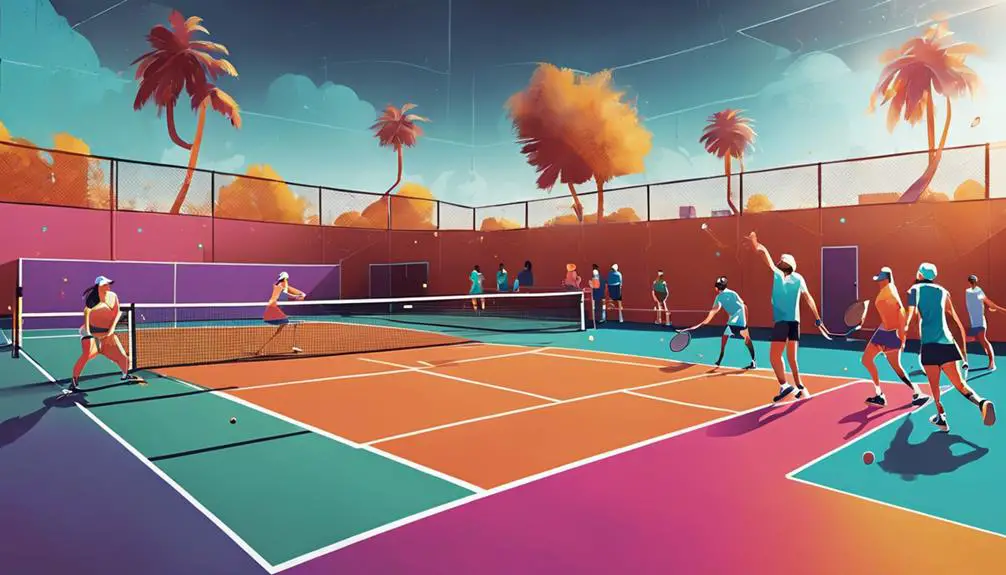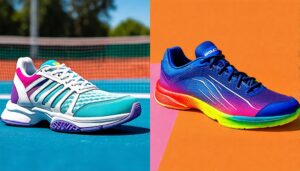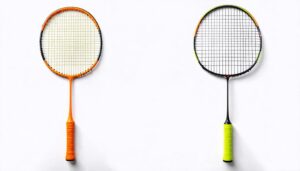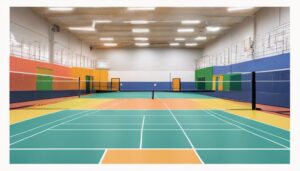When comparing calories burned, both pickleball and tennis typically allow you to burn between 400 to 600 calories per hour. However, the intensity and style of play can impact this figure. In tennis, the larger court encourages longer runs and sustained effort, often leading to higher caloric expenditure during extended rallies. Pickleball offers a more relaxed pace on a smaller court, making it easier for longer playbut still challenges your agility and coordination. Your choice may depend on whether you’re after explosive play or endurance. Exploring these factors can help clarify which sport fits your fitness goals best.
Overview of Pickleball
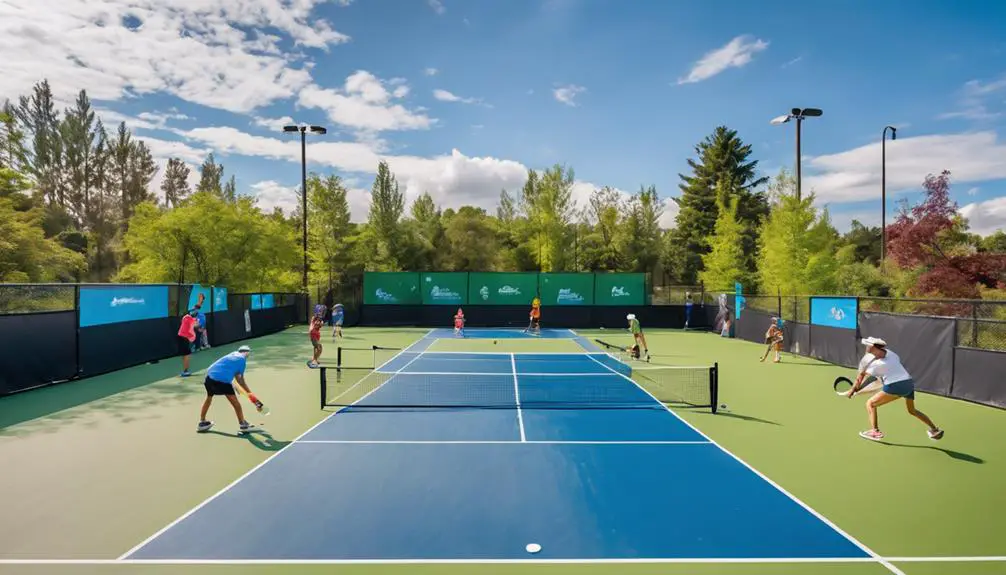
When considering recreational sports, pickleball has emerged as a popular choice, blending elements of tennis, badminton, and ping pong. Originating in the mid-1960s, pickleball’s history is rooted in a desire to create a fun, family-oriented game. It was invented by Joel Pritchard, Bill Bell, and Barney McCallum on Bainbridge Island, Washington, as a solution to entertain their children. Since then, its appeal has skyrocketed, particularly among adults seeking a low-impact yet engaging activity.
Understanding the essential pickleball equipment is vital for enjoying the game. A standard pickleball court is smaller than a tennis court, measuring 20 feet wide and 44 feet long for doubles play. Players use a paddle, typically made of wood or composite materials, to hit a lightweight plastic ball with holes. The choice of equipment greatly influences your playing style and performance. For instance, paddles come in various sizes and weights, allowing you to select one that fits your grip and swing preference. The ball’s design, which includes air holes, affects its flight and bounce, adding another layer to game strategy.
As you explore pickleball, you’ll find that its unique combination of simplicity and strategic depth makes it accessible yet challenging. It fosters a sense of community and competition, appealing to a wide range of players. Engaging in this sport not only promotes physical fitness but also provides a social outlet, making it an excellent choice for those seeking freedom in their recreational activities.
Overview of Tennis
Integrating elements of agility, strategy, and endurance, tennis has long been celebrated as a dynamic sport enjoyed worldwide. With roots tracing back to the late 12th century in France, tennis history reveals a rich evolution from the medieval game of jeu de paume to the modern, fast-paced version we see today. As you explore tennis, you’ll find its blend of physical and mental challenges offers numerous benefits.
Here are some key advantages of playing tennis:
- Improved cardiovascular fitness: Regular play elevates your heart rate, enhancing overall heart health.
- Increased agility and coordination: The quick movements required in tennis sharpen your reflexes and improve hand-eye coordination.
- Enhanced mental focus: Strategy plays a vital role, demanding concentration and tactical thinking.
- Social engagement: Whether playing doubles or participating in clubs, tennis fosters connections and camaraderie.
The sport not only contributes to physical fitness but also promotes mental well-being. Engaging in tennis can reduce stress, boost mood, and enhance cognitive function. It’s a full-body workout, drawing upon various muscle groups while providing an exciting social outlet.
Tennis stands as a reflection of the idea that physical activity can be both enjoyable and beneficial. Embracing its history and understanding its multifaceted benefits can inspire you to pick up a racket and join in this global pastime. Whether you’re a beginner or a seasoned player, the sport offers a freedom of movement and expression that few activities can match.
Factors Affecting Caloric Burn

Understanding the factors affecting caloric burn during activities like pickleball and tennis can help you make informed choices about your exercise routines. Several elements play a vital role in determining how many calories you burn while participating in these sports.
Age factors can’t be ignored; as you age, your metabolism tends to slow down, potentially leading to lower caloric expenditure. Your fitness level is equally significant; the more conditioned you are, the more efficiently your body utilizes energy. Additionally, the playing duration directly impacts caloric burn—longer sessions understandably result in more calories burned.
The court surface also matters. Playing on a hard court requires more energy than a softer surface, like grass, due to its increased impact on your joints. Your player style influences caloric expenditure, too; aggressive, fast-paced play typically leads to higher intensity and, consequently, more calories burned.
Weather conditions can’t be overlooked either. Extreme heat or cold can affect your performance and energy expenditure. Finally, the equipment type—such as racquets and shoes—can influence your movement and comfort on the court, impacting your overall intensity and duration of play.
Incorporating these factors into your considerations will help you maximize your workout efficiency. By understanding these variables, you can tailor your pickleball or tennis sessions to better meet your fitness goals.
Average Calories Burned in Pickleball
On average, players can burn between 400 to 600 calories per hour while playing pickleball, depending on various factors such as intensity, skill level, and individual body composition. This calorie estimation highlights one of the many pickleball benefits, making it an effective way to stay fit while having fun. The combination of quick lateral movements, strategic shots, and social interaction contributes to an engaging workout.
When you immerse yourself in a game, several elements can influence how many calories you burn:
- Intensity of Play: The more aggressively you play, the more calories you’ll burn.
- Skill Level: Advanced players may cover more ground and hit harder, increasing caloric expenditure.
- Body Composition: Heavier individuals typically burn more calories than lighter ones during the same activity.
- Game Duration: Longer games naturally equate to higher calorie burn.
Understanding these factors can help you maximize your workout and tailor your gameplay to suit your fitness goals. Plus, the social aspect of pickleball can motivate you to play more frequently, boosting your overall activity levels.
Whether you’re playing recreationally or competitively, pickleball offers a dynamic way to enhance your fitness routine. So, grab your paddle, invite some friends, and enjoy the many benefits that come with this exhilarating sport while you torch those calories!
Average Calories Burned in Tennis

While pickleball offers an engaging workout, tennis is also a formidable contender regarding calorie burning. When you step onto the court, the combination of quick movements, strategic plays, and varied intensity can lead to significant calorie expenditure. On average, players can burn between 400 to 600 calories per hour depending on their weight, skill level, and the intensity of play.
To give you a clearer picture, here’s a breakdown of average calories burned in tennis based on different player weights and activity levels:
| Weight (lbs) | Moderate Play (calories/hr) | Intense Play (calories/hr) |
|---|---|---|
| 130 | 360 | 540 |
| 150 | 420 | 600 |
| 180 | 500 | 720 |
| 200 | 540 | 780 |
| 220 | 600 | 840 |
Engaging in tennis not only helps with weight loss but also promotes cardiovascular health, coordination, and agility. The various tennis techniques you employ, from serves to volleys, enhance your skill set while boosting your fitness levels. As you experiment with different shots and strategies, you’ll notice how versatile tennis is, providing both physical and mental challenges.
Comparing Intensity Levels
When you immerse yourself in a game of pickleball or tennis, the intensity levels can vary considerably, influencing the number of calories you burn. Both sports offer unique gameplay dynamics that impact how hard you work during a match. The intensity comparison between pickleball and tennis often reveals that tennis generally requires more sustained energy output due to its larger court size and faster-paced rallies.
In pickleball, the smaller court and slower ball speed can lead to shorter bursts of activity. However, the game still demands quick reflexes and strategic movement, which can elevate your heart rate. On the other hand, tennis players must cover more ground, engage in longer rallies, and often sprint to hit hard serves or returns, leading to higher overall intensity levels.
Consider these factors when comparing the intensity of the two sports:
- Court Size: Tennis courts are larger, promoting longer runs and increased calorie expenditure.
- Rally Length: Tennis rallies can be more intense and prolonged, requiring sustained effort.
- Pace of Play: Pickleball allows for quicker points, but tennis may push you to exert more energy over time.
- Skill Levels: Advanced players in either sport will likely experience higher intensity due to more competitive gameplay dynamics.
Ultimately, your choice of sport may depend on how you want to engage with the activity—whether you prefer the explosive nature of pickleball or the endurance challenge of tennis.
Choosing the Right Sport
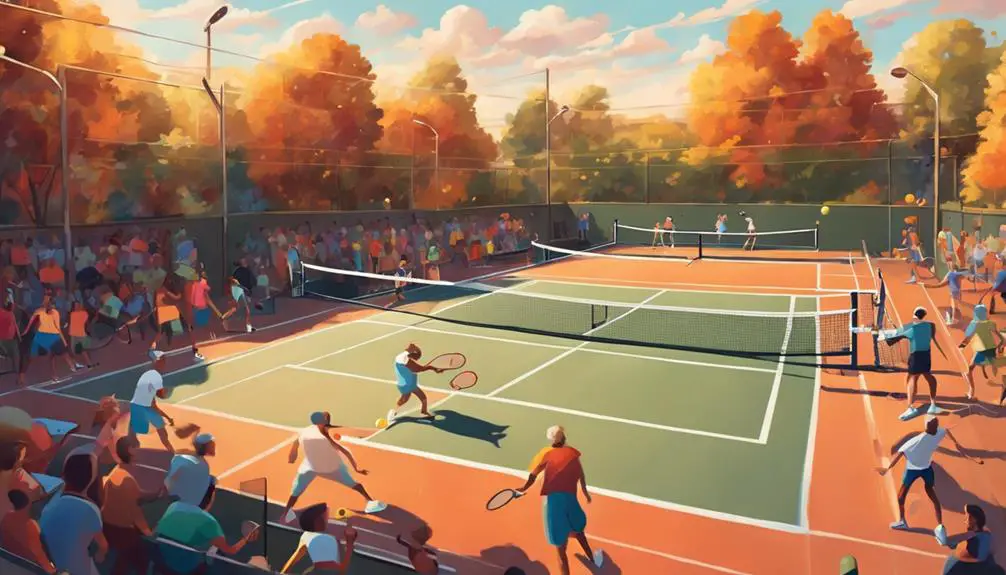
Deciding between pickleball and tennis can often come down to your personal fitness goals and preferences. Both sports offer significant health benefits, but they cater to different needs and skill levels. If you’re looking for a more social, less intense experience, pickleball might be your ideal choice. Its smaller court size and slower pace can make it less physically demanding, allowing for longer play sessions without excessive fatigue. Studies have shown that pickleball promotes cardiovascular health while enhancing coordination and agility.
On the other hand, if you’re drawn to a higher intensity workout that challenges your endurance and strength, tennis may be the better option. The larger court requires more movement, which can lead to greater calorie expenditure and improved fitness levels over time. The dynamic nature of tennis also fosters skill development through varied strokes and strategies, enhancing your overall athleticism.
Consider your current fitness level as well. If you’re just starting out, pickleball is often easier to pick up, allowing for quick skill acquisition and immediate enjoyment. For those with a foundation in sports, tennis can provide a rewarding challenge that encourages further development.
Ultimately, both sports can offer you a fulfilling way to stay active. Weigh the health benefits, your desired level of intensity, and how each sport aligns with your skill development goals. This will help you make an informed decision that suits your lifestyle and fitness aspirations.
Frequently Asked Questions
How Do Age and Fitness Level Impact Calorie Burn in These Sports?
Age factors and fitness variations greatly influence how many calories you burn during sports. As you age, metabolic rates decrease, and higher fitness levels generally enhance calorie expenditure, allowing you to maximize your workout efficiency.
What Equipment Can Enhance Calorie Burning During Pickleball or Tennis?
Using heavier rackets can increase resistance, enhancing calorie burn during play. Additionally, choosing a more challenging court surface like clay can elevate your effort level, further maximizing your workout potential and improving overall fitness.
Can Playing Style Affect the Number of Calories Burned?
Yes, your playing style can greatly influence calorie burn. Aggressive play demands more energy, while strategic movement can optimize efficiency. Balancing both approaches can maximize your workout, enhancing enjoyment and freedom on the court.
How Does Playing Doubles Compare to Singles in Calorie Expenditure?
When considering doubles dynamics versus singles strategy, you’ll find that singles typically demands more constant movement, potentially leading to higher calorie expenditure. However, doubles can engage different muscle groups, offering varied physical benefits and enjoyment.
Are There Specific Warm-Up Exercises to Maximize Calorie Burn?
To maximize calorie burn, incorporate dynamic stretching and high-intensity movements into your warm-up. This approach not only prepares your muscles but also elevates your heart rate, enhancing overall performance and energy expenditure during gameplay.

